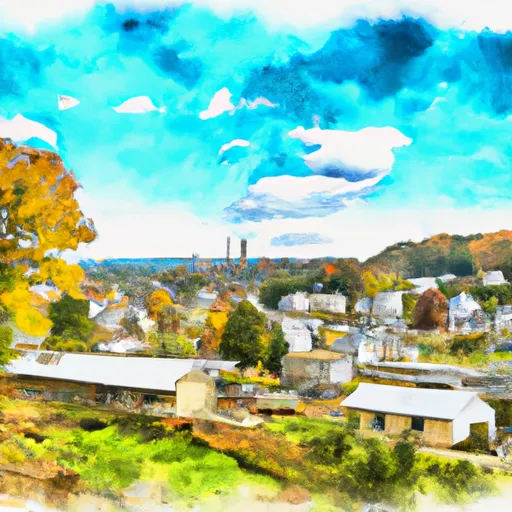-
 Snoflo Premium
Snoflo Premium
Get unlimited access to all our content
With no Ad interruptions! - Start Your Free Trial Login with existing account
Fallentimber
Eden Index
Climate
8.6
•
Recreation
3.1
•
Community
•
Safeguard
4.5/10

Fallentimber is a small borough located in Cambria County, Pennsylvania. The climate in Fallentimber is characterized by cold winters and warm summers, with an average temperature of 51°F. The area receives an average of 40 inches of rainfall and 40 inches of snowfall annually. The hydrology constituents in Fallentimber are mainly composed of the Little Conemaugh River, which flows through the borough. The river provides opportunities for fishing and boating. The surrounding forests offer opportunities for hiking and hunting. There are also several parks and recreational areas nearby for residents and visitors to enjoy. Overall, Fallentimber is a peaceful and picturesque community with plenty of outdoor recreation opportunities.
What is the Eden Index?
The Snoflo Eden Index serves as a comprehensive rating system for regions, evaluating their desirability through a holistic assessment of climate health, outdoor recreation opportunities, and natural disaster risk, acknowledging the profound impact of these factors on livability and well-being.
Climate Health Indicator (CHI): 8.6
Fallentimber receives approximately
1048mm of rain per year,
with humidity levels near 79%
and air temperatures averaging around
9°C.
Fallentimber has a plant hardyness factor of
5, meaning
plants and agriculture in this region thrive during a short period during spring and early summer. Most
plants will die off during the colder winter months.
By considering the ideal temperature range, reliable water supplies, clean air, and stable seasonal rain or snowpacks, the Climate Health Indicator (CHI) underscores the significance of a healthy climate as the foundation for quality living.
A healthy climate is paramount for ensuring a high quality of life and livability in a region, fostering both physical well-being and environmental harmony. This can be characterized by ideal temperatures, reliable access to water supplies, clean air, and consistent seasonal rain or snowpacks.
Weather Forecast
Streamflow Conditions
West Branch Susquehanna
Area Rivers
West Branch Susquehanna
Snowpack Depths
West Branch Susquehanna
Reservoir Storage Capacity
West Branch Susquehanna
Groundwater Levels
Recreational Opportunity Index (ROI): 3.1
The Recreational Opportunity Index (ROI) recognizes the value of outdoor recreational options, such as parks, hiking trails, camping sites, and fishing spots, while acknowledging that climate plays a pivotal role in ensuring the comfort and consistency of these experiences.
Access to outdoor recreational opportunities, encompassing activities such as parks, hiking, camping, and fishing, is crucial for overall well-being, and the climate plays a pivotal role in enabling and enhancing these experiences, ensuring that individuals can engage in nature-based activities comfortably and consistently.
Camping Areas
| Campground | Campsites | Reservations | Toilets | Showers | Elevation |
|---|---|---|---|---|---|
| Shawnee State Park | None | 1,254 ft | |||
| Fifteen Mile Creek - C and O Canal National Park | 10 | 435 ft | |||
| S.B. Elliott State Park | None | 2,125 ft | |||
| Blue Knob State Park | None | 2,576 ft | |||
| Curwensville Lake | 50 | 1,312 ft | |||
| Prince Gallitzin State Park | None | 1,480 ft | |||
| Rocky Gap State Park | 278 | 1,231 ft | |||
| Canoe Creek State Park | None | 914 ft | |||
| Green Ridge State Forest Dispersed | 100 | 1,076 ft | |||
| Parker Dam State Park | None | 1,621 ft |
Nearby Ski Areas
Catastrophe Safeguard Index (CSI):
The Catastrophe Safeguard Index (CSI) recognizes that natural disaster risk, encompassing floods, fires, hurricanes, and tornadoes, can drastically affect safety and the overall appeal of an area.
The level of natural disaster risk in a region significantly affects safety and the overall livability, with climate change amplifying these risks by potentially increasing the frequency and intensity of events like floods, fires, hurricanes, and tornadoes, thereby posing substantial challenges to community resilience and well-being.
Community Resilience Indicator (CRI):
The Community Resilience Indicator (CRI) recognizes that education, healthcare, and socioeconomics are crucial to the well-being of a region. The CRI acknowledges the profound impact of these elements on residents' overall quality of life. By evaluating educational resources, healthcare accessibility, and economic inclusivity, the index captures the essential aspects that contribute to a thriving community, fostering resident satisfaction, equity, and social cohesion.

